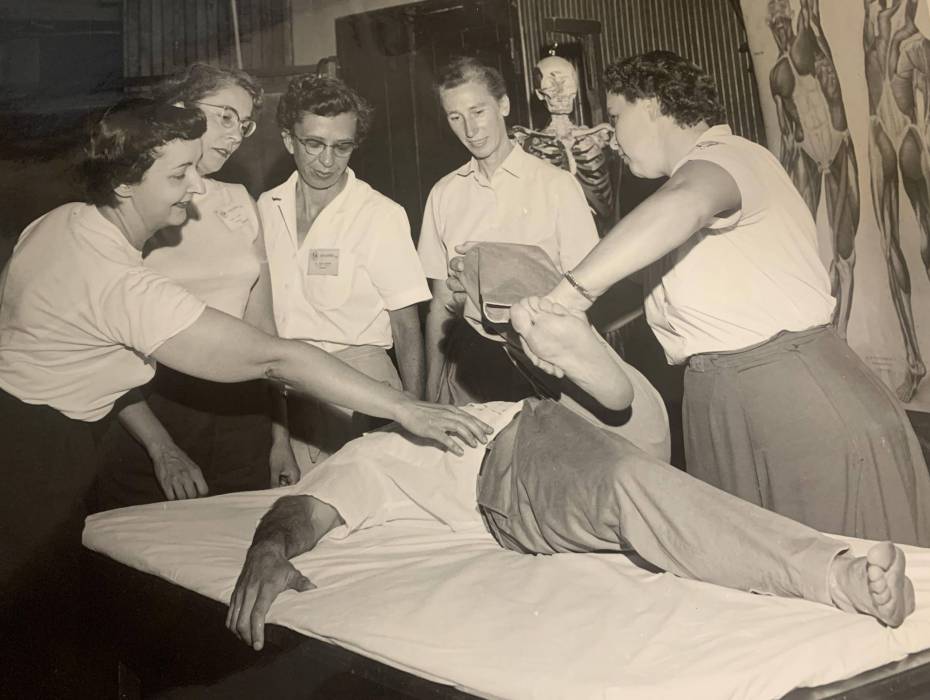Initially termed ‘proprioceptive facilitation’ by Dr Herman Kabat in the early 1940’s, physical therapist Dorothy Voss added the word ‘neuromuscular’ to give us the now familiar Proprioceptive Neuromuscular Facilitation (PNF).
Kabat’s conceptual framework for PNF came from his experience as a neurophysiologist and physician, and the works of Sister Elizabeth Kenney, an Australian nurse who treated polio patients with specific stretching and strengthening activities. Kenney’s work was seen as a departure from the normal treatment at the time, but lacked the grounding of sound neurophysiological rationale. Kabat integrated Kenney’s manual technique with Sir Charles Sherrington’s discoveries of successive induction, reciprocal innervation and inhibition, and the phenomenon of irradiation.
Kabat’s goal was to develop a hands-on treatment approach that enabled clinicians to analyze and assess a patient’s movement while at the same time facilitating more efficient strategies of functional movement.
In the mid-1940’s, Kabat’s emerging concepts caught the attention of the wealthy industrialist Henry Kaiser, whose son suffered from multiple sclerosis. Together, in 1946, they established the Kaiser-Kabat Institute in Washington, DC. In 1948, another Kaiser-Kabat Institute was opened in Vallejo, California, and a third opened in Santa Monica, California in 1950.
Kabat needed a Physical Therapist to work alongside him, treating patients using his new concepts. In December 1945 Maggie Knott was employed by Kabat, and moved with him from Washington, DC to Vallejo in 1948.
Knott began to teach other Physical Therapists the patterns and techniques of PNF. That same year she started a post-graduate training program that has been attended by therapists from all over the world. The program still exists today, with a dedicated clinical staff training graduate physical therapists in three and six-month residency programs.
In 1952, Dorothy Voss joined Kabat and Knott. Knott and Voss authored the first PNF book in the early 1960’s. Together, the three continued to develop and refine the foundational concepts of PNF.
References:
History of PNF. International PNF Association. Accessed online from https://www.ipnfa.org/organisation/history-of-pnf on 15 March 2022.


Thank you very much for this Article on the brief History of how PNF came to be. I am a Physical Therapist with post graduate Manual Therapy Training per Ola Grimsby. I also was lucky to be taught a full semester PNF class in PT school by 2 instructors who had completed a 3 month and a 6 month program. I have the 3rd Edition of the PNF Text Book. I often refer to this book. My wife is a Dietician and we have had our own practice in the downstairs of our house just 15 minutes from downtown Fairbanks Alaska. We live on 30 miles of maintained trails that the Fairbanks Dog Musher’s Club and the Skijor/Pulk association maintain. For the past 30 years we have been in this house and over 2 decades our large downstairs windows in our clinic looked out on our dog yard which at it’s peak had 18 dogs a lot for just being Skijorers.
I am immensely more proud to be a PT and continue to use the Concepts of Sister Kenny, (what a fantastic woman and a great empirical practitioner, her Australian and USA story was great to read tonight at a different online site), Sherington, Kabat, Knot, Voss, Rood and many others. During PT school I used to tag along with one of my Professors that worked with Rood and at a Hospital that one of my sisters was born in. I actually went to the same High School as he did and not until PT school did I meet him. The research continues to build on their concepts that they discovered in Scientific Studies and in Empirical experience. I will always feel proud and indebted to these Pioneers in Physical Medicine and Rehabilitation.
Big Thanks again Glenn Roscoe PT.
Sincerely Yours
George Y Salmon PT